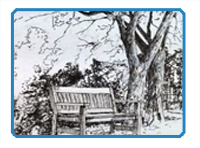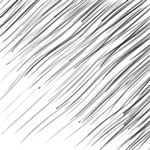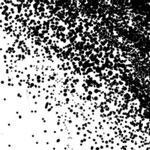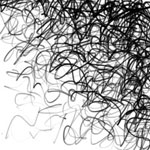
By Matt Fussell
Pen and ink drawings are crisp and informative. Pen and ink is immediate, permanent, portable, reproduces well, and provides high contrast. This medium is very popular for subjects that reflect its inherent characteristics. Architecture, vehicles, machinery, and drawings that are scientific in nature are all popular subjects for pen and ink drawings. Landscape drawing is also included in this category.
An artist may choose to approach pen and ink drawing with a traditional nib pen or with a more modern solution. Nib pens consist of a shaft with a nib tip. Nibs come in a variety of sizes that produce different types of marks and can be changed. Nib pens are dipped into a container of ink and then moved across the drawing surface to produce marks. Most nib pens are designed to “hold” the ink in the nib as the marks are made. Larger nibs logically hold more ink. The artist must be thoughtful when making marks with a nib pen. The pens should be “pulled” across the surface. “Pushing” the pen against the nib will result in splattering of the ink. Nib pens are versatile and produce marks that hard to duplicate with modern pens. Many artists, however choose to use modern pens out of convenience.
Modern pens include an internal reservoir that serves the ink to the tip. Tips vary in size. Pens can be purchased that are disposable or refillable. A popular choice for disposable pens are Micron pens made by Sakura. While a popular choice for refillable pens are Kor-I-Noor Rapidograph pens.
Whether the artist chooses to use a nib pen or a modern drawing pen, the techniques remain the same. The artist may choose to use use one drawing technique exclusively in order to create unity in the artwork, or they may choose to use several techniques in order to create variety.
Hatching - Value is created using lines that generally go in the same direction. Hatching may be used to create the illusion of form of a drawing through cross contour lines. The closer that lines are to each other, the darker the value appears.

Cross-Hatching - Value is created using lines that cross over each other.

Stippling - Small dots are used to create value in the drawing. The frequency and density of the dots control the value perceived by the viewer.

Random Lines - Freeform lines cross over each other to produce a range of value. The more the lines cross over each other, the darker the value becomes.

The following video features excerpts from a 1 hour Live Lesson on drawing a landscape using pen and ink. In this video, a variety of techniques are used. As is often the case with pen and ink landscape drawing, the technique is chosen based on the texture of the object in the drawing. For the rigid bench, hatching and cross-hatching are used, while the leaves on the trees are rendered using random lines.
Here are some more art lessons that you may like...